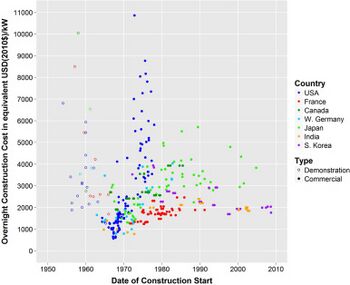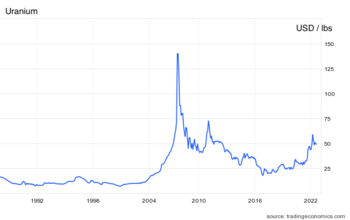Cost of nuclear power
- See also: Nuclear_power_reconsidered
There is much confusion over the measures of cost in power systems. We will use the two most fundamental - capital cost per kilowatt (kW) of peak generating capacity and operating cost per kilowatt-hour (kWh) of energy produced. Capital cost includes construction and all equipment, but not land or transmission lines, or government subsidies and taxes. Operating cost includes fuel, maintenance and administration, but not licenses or taxes. For storage systems, capital cost is normally per kWh of capacity, not total kWh delivered over a lifetime, and includes all ancillary equipment, like chargers and inverters.
Levelized cost is another measure that attempts to combine capital and operational costs in one number. It depends on the lifetime of assets, an assumed interest rate, and salvage value of the assets at end of life. Think of it as operating cost plus a mortgage payment.

Fig.1 Construction costs for Pressurized Water Reactors (PWRs) have varied due to the political and regulatory environments in each country.[1]
Historical Costs
see Fig.1
Existing nuclear plants have been very expensive, due to the inherent risks in pressurized water reactors (PWR's) and the need for expensive structures and burdensome regulations to deal with that risk. Newer designs promise to be much simpler, safer, and manufactured on an assembly line as replaceable parts, rather than site built.
Cost of new designs
Vendors step up. We need your numbers.
ThorCon MSR:
$1200 per kW + $0.03 per kWh promised.[2]
GE Hitachi BWRX-300:
$2250 per kW promised.[3]

Cost of fuel
Uranium is currently $110 per kg. See Fig.2 for the price history. Uranium is traded on the New York Mercantile Exchange. Top producers are Kazakhstan, Canada and Australia.
Thorium is about $30 per kg and is about three times more abundant than uranium.[5]
A kilogram of uranium has ___ kWh of stored energy. A Light Water Reactor (LWR) uses only 0.5% of this. A Fast Neutron Reactor (FNR) can use it all.
A CANDU reactor uses natural uranium (0.7% enrichment). LWRs need 3 to 5% enrichment. Some newer generation reactors need up to 20% enrichment.
Average cost of enrichment in 2021 was $99 per SWU (Separative Work Unit).[6]
See also Uranium Enrichment.
Cost of alternatives
Capacity Factor (CF) is often ignored in discussions of intermittent sources like wind and solar. A typical rooftop solar panel system with a nameplate rating of 12 kW and a sunny climate in the Arizona desert will deliver 10 kW peak and 3 kW average over a year. A realistic cost per kW is therefore four times the often quoted cost. This does not include the cost of batteries, or any other storage that might be necessary for a regional utility. Storage is not necessary for rooftop systems, if the utility can provide full credit for power returned to the grid. The challenge for the utility is load following. If the fraction of total power on the grid from intermittent sources is too large, there will be extra expense for batteries or generators held as "spinning reserve" for rapid response when the intermittents drop out.
If the goal is 100% wind and solar, then we must add in the cost of storage. The most promising possibility is hydrogen at $0.12 per kWh (see below). Assuming this cost is distributed evenly over all demand, then the added cost per kWh depends on what fraction of the total power is delivered from storage. If that fraction is 1/3, then the added cost for all customers is $0.04 per kWh.
The bigger challenge is capital cost. A 10 GW regional grid with 3 GW average demand might need 100 hours of storage, or 300 GWh. This depends on the tolerance of the population for occasional outages when there is bad weather more than 100 hours, and there may be some additional cost for backup generators at hospitals and other critical services. Assuming that 100 hours of backup is the compromise, and we need to hold capital cost to no more that $10 billion, our storage facility can be no more than $30 per kWh (10% the current cost of batteries).
Rooftop Solar (no batteries):
$2,900 per kW (nameplate),[7]
$11,600 per kW avg (25% Capacity Factor)
Wind Turbines
$770–$850 per kW (nameplate), down from $1800 in 2008.[8]
$3240 per kW avg (25% Capacity Factor)
Batteries:
USA Average in 2019: $589 per kWh, down 72% since 2015.[9]
Redox Flow Batteries: $25 per kWh promised.[10]
Iron Flow Batteries: < $20 per kWh "incremental cost" promised.[11]
Hydrogen:
Worldwide hydrogen production stood at 90 Mt in 2020, but since it was produced almost exclusively from fossil fuels, the result was close to 900 Mt of CO2 emissions.[12]
"Green" hydrogen (no CO2) can be produced from water using electrolysis, but the cost is much higher.[13]
There is also a possibility of separating hydrogen directly from water using a chemical process and abundant heat. See Energy_storage#Hydrogen for more on this.
$2 per kg promised by mid 2020s[14][15]
$1 per kg ten-year goal set by DOE[16]
$0.12 per kWh electrical energy storage cost, assuming $2 per kg of H2, and 50% overall efficiency.[17]
Notes and References
- ↑ Fig.12 in Lovering 2016 "Historical construction costs of global nuclear power reactors" https://doi.org/10.1016/j.enpol.2016.01.011
- ↑ ThorCon's estimate of costs.
- ↑ BWRX-300 Fact Sheet 2021
- ↑ TradingEconomics.com/commodity/uranium downloaded 27 Aug 2022.
- ↑ Thorium Data Sheet - Mineral Commodity Summaries 2020, USGS.gov
- ↑ EIA.gov/uranium/marketing
- ↑ Quote from a solar panel installer in Arizona.
- ↑ DOE report 30 Aug 2021
- ↑ Battery Storage in the United States: An Update on Market Trends, EIA 2021
- ↑ Researchers Claim Redox Flow Battery Breakthrough Will Cost $25 Per KWh Or Less, Warwick University, Jan 2021.
- ↑ ESS Inc website Aug 2022.
- ↑ See the section "Hydrogen supplies are becoming cleaner … too slowly" in the IEA Global Hydrogen Review 2021.
- ↑ Depending on regional gas prices, the levelized cost of hydrogen production from natural gas ranges from $0.50 to $1.70 per kg. See the section "Low-carbon hydrogen can become competitive within the next decade" in the IEA Global Hydrogen Review 2021.
- ↑ Australian company Hysata says their new Capilary-Fed Electrolyzer will deliver 95% efficiency - PV Magazine 8/2/2022.
- ↑ Bristol Springs Solar project in Western Australia could generate hydrogen for less than $2/kg - PV Magazine 8/2/2022
- ↑ Department of Energy's "Hydrogen Shot"
- ↑ Energy density of H2 is 33 kWh/kg. ($2/kg / 33 kWh/kg / 50%) = $0.12/kWh.